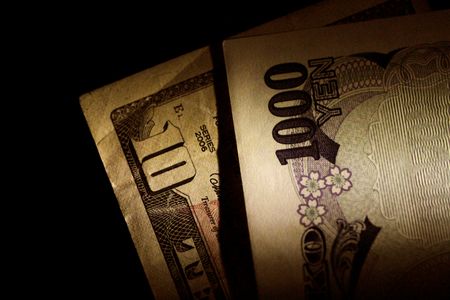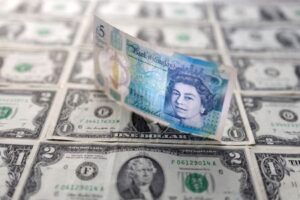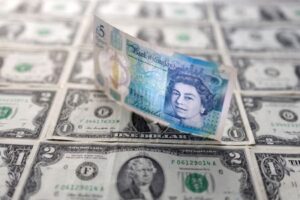By Gertrude Chavez-Dreyfuss
NEW YORK (Reuters) -The yen sank to a 38-year low against the U.S. dollar and a record trough versus the euro on Wednesday, as the Japanese unit continued its downward spiral, with market participants on high alert for Japanese intervention to boost the currency.
The dollar, on the other hand, fell after a slew of softer-than-expected U.S. economic data that bolstered expectations that the Federal Reserve will likely start cutting interest rates later this year.
It declined after data showed that U.S. private payrolls rose slightly less than expected in June and initial jobless claims increased, both consistent with a slowing labor market.
A report indicating that the U.S. services sector contracted last month and factory orders fell also weighed on the dollar.
With the greenback on the defensive, the euro remained resilient, helped by a stubbornly high inflation reading on Tuesday that suggested the European Central Bank would take its time before cutting interest rates again. Sterling, meanwhile, gained before Thursday’s UK election.
Ahead of the July 4th holiday in the United States, the yen remained the main focus as it fell to 161.96 per dollar for the first time since December 1986. The dollar was last up 0.1% at 161.64, after earlier falling to a session low below 161 following weak U.S. data.
The yen also hit an all-time low of 174.48 against the euro. The euro was last up 0.4% at 174.22 yen.
“The BOJ (Bank of Japan) might actually have to wait until the Fed cuts interest rates and adopt a sort of ‘benign neglect’ policy,” said Helen Given, FX trader, at Monex USA in Washington.
“U.S. yields are simply still too high for an intervention to take hold – it’s going to take a catalyst on the U.S. dollar side to bring them lower and that could come from the Fed.”
Japanese authorities have been largely quiet on the yen this week, with Finance Minister Shunichi Suzuki only commenting on Tuesday that moves were being watched vigilantly. He refrained from repeating the often used warning that the ministry stood ready to act.
WEAK DATA SLAMS US DOLLAR
Wednesday’s data overall depicted a U.S. economy that is slowing down, undermining the dollar.
Initial applications for U.S. unemployment benefits increased last week, while the number of people still on jobless rolls rose further to a 2-1/2 year high toward the end of June. First-time jobless claims rose to a seasonally adjusted 238,000 for the week ended June 29.
The number of people receiving benefits after an initial week of aid increased to a seasonally adjusted 1.858 million in the week of June 22, the highest since late November 2021.
Separately on Wednesday, the ADP Employment report showed private payrolls grew by 150,000 jobs in June after rising 157,000 May. Economists polled by Reuters had forecast private employment increasing by 160,000.
“The economic data surprises in the U.S. are now undershooting expectations relative to other major economies, which has generally coincided with periods of dollar weakness,” wrote Jonas Goltermann, deputy chief markets economist, at Capital Economics in a note after Wednesday’s data.
“Taken together, we think the next major move in the greenback will be lower. We forecast the (dollar index) to end this year around 106, near its current level, before falling to 98 by the end of 2025.”
The dollar index, which measures the currency against six major counterparts, slid 0.2% to 105.41. It dropped to a three-week low earlier in the session.
The euro rose to a three-week high against the dollar, and was last up 0.3% at $1.0781.
Further pressuring the dollar was a weak U.S. services report from the Institute for Supply Management. The data showed a reading of 48.8, a four-year low, from 53.8 in May. It was the second time this year that the PMI had dropped below 50, which indicates contraction in the services sector.
U.S. factory orders also eased 0.5% in May, below expectations for an increase.
Following the barrage of U.S. data, U.S. rate futures have priced in a 74% chance of a rate cut in September, up from 69% late on Tuesday, according to LSEG calculations. The market has also priced two rate cuts in 2024.
Fed officials at their last meeting acknowledged the U.S. economy appeared to be slowing and that “price pressures were diminishing.” They still advocated for a wait-and-see approach before committing to interest rate cuts, according to minutes of the two-day gathering held on June 11-12.
The focus now shifts to Friday’s nonfarm payrolls report, which is expected to show an increase of 190,000 jobs in June after rising 272,000 in May, according to a Reuters poll of economists. The unemployment rate is forecast to be unchanged at 4.0%.
Currency
bid
prices at
3 July
06:25
p.m. GMT
Descripti RIC Last U.S. Pct YTD Pct High Low
on Close Change Bid Bid
Previous
Session
Dollar 105.4 105.67 -0.25% 3.98% 105.8 105.
index 04
Euro/Doll 1.0778 1.0746 0.31% -2.35% $1.0817 $1.0
ar 736
Dollar/Ye 161.64 161.43 0.07% 14.53% 161.945 160.
n 895
Euro/Yen 1.0778 173.45 0.44% 11.94% 174.51 173.
45
Dollar/Sw 0.9018 0.904 -0.24% 7.15% 0.905 0.89
iss 86
Sterling/ 1.2733 1.2686 0.38% 0.07% $1.2777 $1.0
Dollar 736
Dollar/Ca 1.364 1.3678 -0.26% 2.91% 1.3686 1.36
nadian 18
Aussie/Do 0.6699 0.6668 0.5% -1.72% $0.6734 $0.6
llar 664
Euro/Swis 0.9719 0.9712 0.07% 4.65% 0.9737 0.97
s 08
Euro/Ster 0.8461 0.8469 -0.09% -2.39% 0.8478 0.84
ling 59
NZ 0.6098 0.6078 0.42% -3.41% $0.6129 0.60
Dollar/Do 7
llar
Dollar/No 10.5624 10.6679 -0.99% 4.22% 10.6953 10.5
rway 268
Euro/Norw 11.3827 11.4634 -0.68% 1.44% 11.4925 11.3
ay 8
Dollar/Sw 10.5106 10.576 -0.62% 4.41% 10.5911 10.4
eden 66
Euro/Swed 11.3283 11.3644 -0.32% 1.82% 11.3808 11.3
en 104
(Reporting by Gertrude Chavez-Dreyfuss; Additional reporting by Amanda Cooper and Dhara Ranasinghe in London, and Kevin Buckland in Tokyo; Editing by Sharon Singleton, Andrea Ricci andEditing by Sandra Maler)





